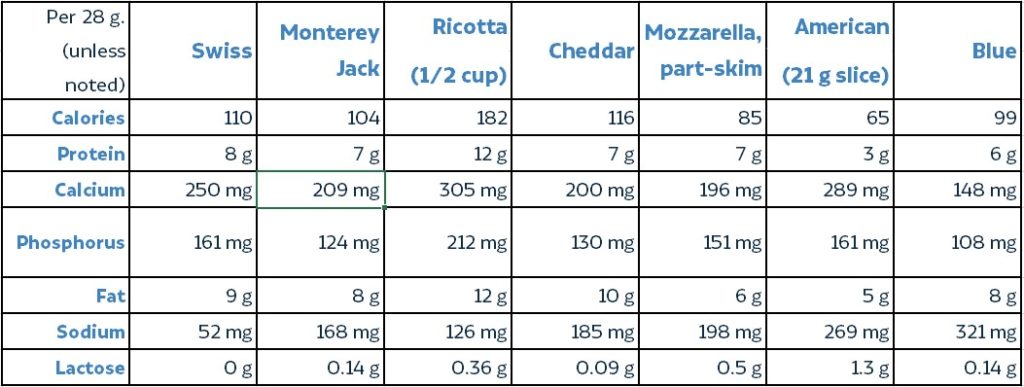The 2020-2025 Dietary Guidelines for Americans found that 90% of Americans need to increase their intake of dairy products. Cheese can be a great option for adding a serving of dairy to a healthy eating pattern. Cheese is a flexible way to get a serving of nutrient-dense dairy: it can be a snack on its own or as part of an entrée or meal.
Cheese is an important source of high-quality protein, especially for meat-free meals or snacks. In fact, cheese even included as a meat alternate in the school meal programs! And when cheese is visibly served with other nutrient-dense foods, like fruits, vegetables and whole grains, the consumption of those other healthy options is also increased.[i]
With hundreds of varieties of cheeses that have different taste, texture and nutritional profiles, there is a cheese that meets the preferences and nutritional needs for everyone.

Cheese is a nutrient-dense food, providing a good source of protein, calcium and phosphorous. Its contributions to the diets of Americans include: 27% of the calcium, 13% of the phosphorus, 11% of vitamin A and 8% of the protein consumed by Americans.[ii] For children, cheese is an even more important source of nutrition: cheese is the number two source of calcium for children 2-11 and the number 1 source of calcium for children 12-18. Cheese is also in the top five sources of vitamin D for children 2-18.[iii]
In addition to providing essential nutrients and contributing toward dairy intake, many cheeses are naturally low in lactose. This means that cheese can be an important source of calcium for those with lactose intolerance. Natural cheeses such as Cheddar, Colby, Monterey Jack, Mozzarella and Swiss contain minimal amounts of lactose, because most of the lactose is removed when the curds are separated from the whey in the cheese making process.
While salt does add to the flavor of many types of cheese, the underlying reason that salt is added to cheese is for functional purposes including food safety purposes. Salt helps maintain various characteristics associated with cheese, including body, flavor, texture, and shelf life.It is a significant factor in keeping cheese safe by preventing the growth of pathogens and can also help prevent spoilage, extending shelf life, therefore reducing food waste.
Overall, cheese contributes about 8% of the sodium in American diets.[iv] However, different varieties of cheese have very different sodium contents, so if a lower sodium option is preferred, a variety that naturally contains lower levels of sodium, such as Swiss, might be the one for you.
While cheese is available in different fat levels, most cheese purchased in the US are full-fat. This is milkfat, naturally occurring in the milk that the cheese is made from. Cheese supplies 10% of the total fat and 18% of the saturated fat that Americans eat.[v]
But full fat cheese provides the same nutrients as other cheeses. And recent research has shown that there is no harm, and some potential benefits of full fat dairy foods[vi], especially fermented dairy, including cheese.[vii] One specific fat found in milkfat is called Conjugated Linoleic Acid (CLA), which is actually a trans fatty acid (TFA). Scientific evidence from laboratory animal studies has shown that CLA is different than other TFAs and appears to have beneficial health effects.[viii]
[i] Donnelly JE, Sullivan DK, Smith BK, et al. The Effects of Visible Cheese on the Selection and Consumption of Food Groups to Encourage in Middle School Students. J Child Nutr Manag. 2010;34(1).
[ii] National Dairy Council. NHANES 2011-2014. Data Source: Centers for Disease Control and Prevention, National Center for Health Statistics, National Health and Nutrition Examination Survey Data. Hyattsville, MD: US Department of Health and Human Service. http://www.cdc.gov/nchs/nhanes.htm
[iii] O'Neil CE, Nicklas TA, Fulgoni VL 3rd. Food Sources of Energy and Nutrients of Public Health Concern and Nutrients to Limit with a Focus on Milk and other Dairy Foods in Children 2 to 18 Years of Age: National Health and Nutrition Examination Survey, 2011⁻2014. Nutrients. 2018;10(8):1050. Published 2018 Aug 9. doi:10.3390/nu10081050
[iv] National Dairy Council. NHANES 2011-2014. Data Source: Centers for Disease Control and Prevention, National Center for Health Statistics, National Health and Nutrition Examination Survey Data. Hyattsville, MD: US Department of Health and Human Service. http://www.cdc.gov/nchs/nhanes.htm
[v] National Dairy Council. NHANES 2011-2014. Data Source: Centers for Disease Control and Prevention, National Center for Health Statistics, National Health and Nutrition Examination Survey Data. Hyattsville, MD: US Department of Health and Human Service. http://www.cdc.gov/nchs/nhanes.htm
[vi] Mozaffarian D. Dietary and Policy Priorities for Cardiovascular Disease, Diabetes, and Obesity: A Comprehensive Review. Circulation 2016; 133: 187-225
[vii] Mozaffarian D, Dairy Foods, Obesity, and Metabolic Health: The Role of the Food Matrix Compared with Single Nutrients, Advances in Nutrition, Volume 10, Issue 5, September 2019, Pages 917S–923S, https://doi.org/10.1093/advances/nmz053
[viii] Nicolosi RJ, Rogers EJ, Kritchevsky D, Scimeca JA, Huth PJ. Dietary conjugated linoleic acid reduces plasma lipoproteins and early aortic atherosclerosis in hypercholesterolemic hamsters. Artery. 1997;22(5):266-77. PMID: 9209699.